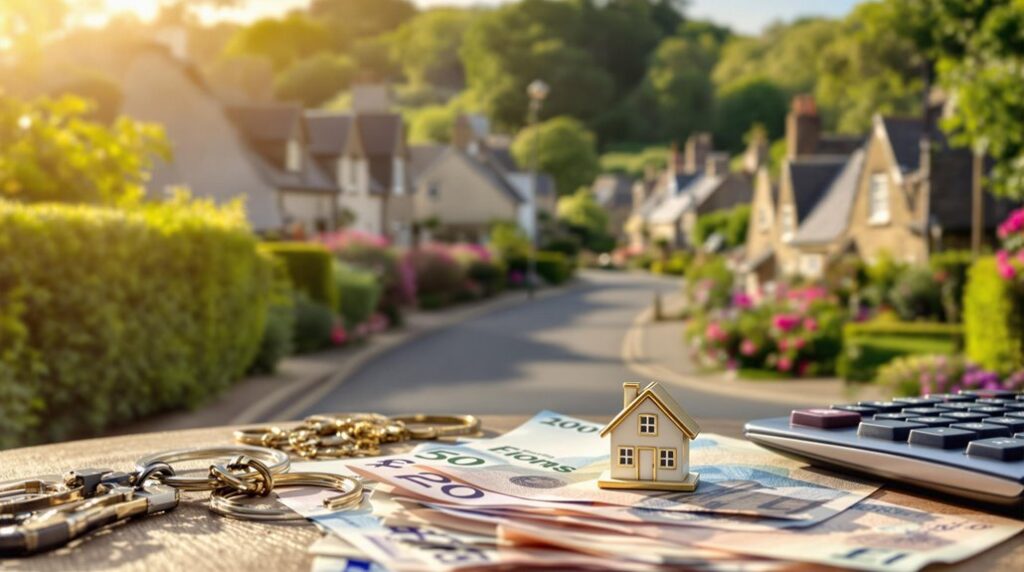I’ve helped dozens of clients navigate Scotland’s property market, and I’ll tell you straight—the numbers don’t always add up the way you’d expect. While Scottish house prices average £191,000 compared to England’s inflated figures, there’s a hidden cost structure that catches most buyers off guard. The Land and Buildings Transaction Tax alone operates on completely different thresholds than England’s stamp duty, and that’s just the beginning of what separates Scottish property purchases from the rest of the UK.
Key Takeaways
- Scottish house prices average £191,000, offering £74,000 savings compared to the UK average of £265,000.
- Budget £18,750 for deposit plus £1,000-£3,000 for legal fees, surveys, and mortgage arrangement costs.
- Land and Buildings Transaction Tax ranges from 0% to 5%, with £4,600 due on £300,000 properties.
- Additional costs include £1,044 removal services and mandatory buildings insurance from contract exchange date.
- Second homes face 6% Additional Dwelling Supplement on entire purchase price with no first-time buyer relief.
Current Scottish Property Prices Compared to UK Market
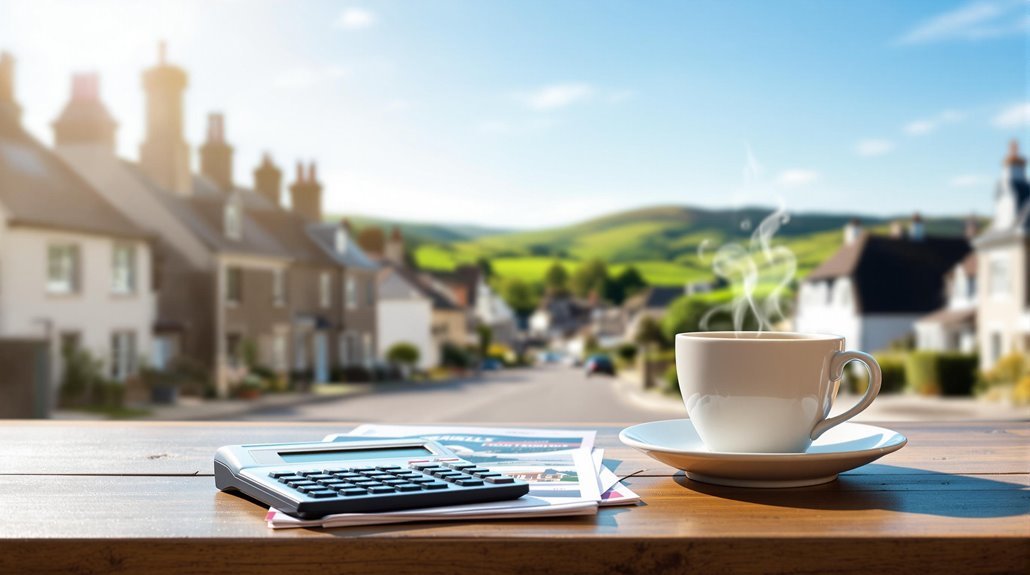
When examining Scotland’s property market against UK-wide trends, you’ll find a substantial affordability advantage that’s reshaping buyer behavior across the region. Scotland’s average house price sits at £191,000—that’s £74,000 below the UK average of £265,000, representing just 72% of national pricing.
Here’s what makes this significant: while you’re getting more value for money, Scottish properties aren’t underperforming. Annual growth reached 5.8% compared to the UK’s 3.5%, with monthly gains of 2.1% against the UK’s -2.7% decline in April 2025. Additionally, current trends in buyer demand indicate that the Scottish market is attracting more first-time buyers. Detached houses led the market with the strongest annual percentage change at 8.3%.
This price differential creates genuine opportunities. You’re accessing markets that outpace national growth while maintaining affordability ratios that actually work for real buyers. Scotland’s resilience demonstrates market fundamentals that favor long-term investment potential.
Annual Price Trends and Monthly Market Movements
Scotland’s property market delivered exceptional performance in 2025, with annual price growth hitting 5.8% in April—nearly double the UK’s 3.5% rate. I’ve analyzed the data showing Scottish houses now average £202,708, while the broader UK sits at £265,000. Additionally, economic indicators suggest that this growth may continue if current trends persist.
Monthly movements tell an interesting story. Scotland’s prices rose 2.1% in April (0.8% seasonally adjusted), contrasting sharply with the UK’s 2.7% decline. This resilience stems from streamlined transactions and stable mortgage conditions. The market’s strength is further evidenced by residential sales reaching 6,100 transactions in February 2025, marking an 11.3% annual increase.
Regional variations matter for your planning. West Lothian leads with 9.1% annual growth, followed by Scottish Borders at 7.8%. ESPC regions averaged 6.6% growth, reaching £285,684. Even prime Edinburgh stabilized with 0.4% quarterly gains after earlier dips, proving Scotland’s market strength across price segments.
Regional Price Variations Across Scotland
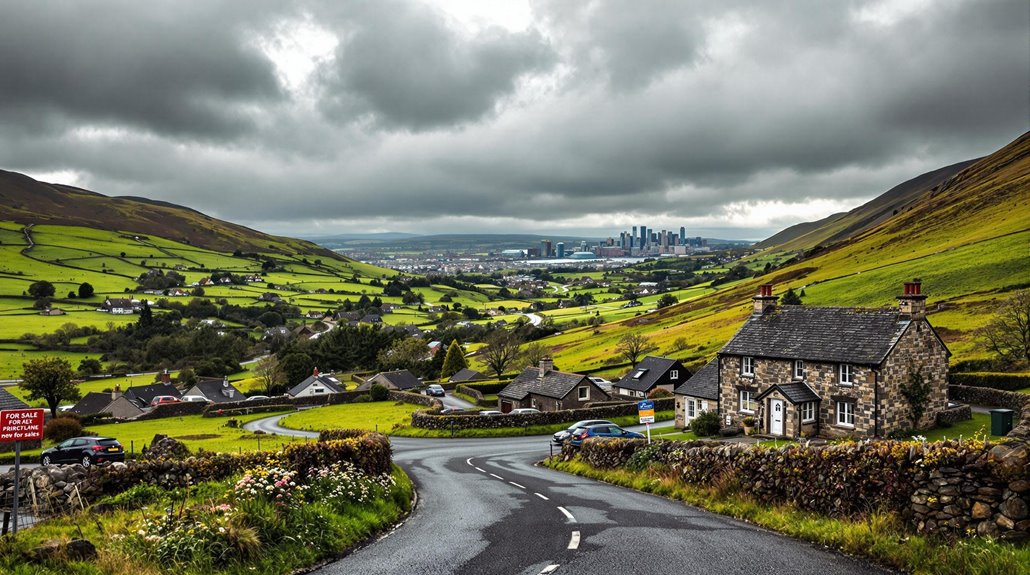
Property prices across Scotland’s regions reveal striking disparities that directly impact your buying power and investment potential. East Renfrewshire commands the highest median at £290,000, while Inverclyde offers the most affordable entry point at £115,000. This £175,000 gap represents significant opportunities depending on your budget and location flexibility. Notably, investing in new build homes can provide modern features and energy efficiency that appeal to many buyers.
Island regions maintain a median of £180,000, compared to mainland Scotland’s £191,000. You’ll find the price range spans from £115,000 to £290,000 across all local authorities, giving you substantial choice in market positioning. Scotland’s housing market is experiencing fastest growth in agreed sales numbers, outpacing southern regions where affordability constraints limit buyer activity.
The overall market distribution shows 66% of sales occur below £250,000, with 29% between £250,000-£525,000, and just 4% exceeding £525,000. This concentration in lower price bands creates competitive conditions for first-time buyers seeking affordable properties.
Additional Purchase Costs Beyond Property Price
Beyond identifying your target price range across Scotland’s regions, you’ll face substantial additional costs that can add 7-15% to your total property investment. I’ll break down these essential expenses you can’t avoid.
Your deposit typically ranges from 5-20% of the purchase price, with Scotland’s average sitting at £18,750. Legal fees will cost £500-£1,500 plus VAT, covering conveyancing and searches. It’s wise to consider transparency in legal costs, as understanding these fees can prevent unexpected expenses. Don’t overlook property inspections—mortgage valuations run £150-£1,500, while thorough surveys cost £400-£1,500+.
Mortgage arrangement fees average £270+, though you can add these to your loan balance. Finally, budget £1,044 for professional removal services.
These costs are non-negotiable, so factor them into your purchasing power calculations from day one. You’ll also need buildings insurance activated from your contract exchange date, as mortgage lenders require this essential protection against major structural damage.
Stamp Duty and Tax Considerations for Scottish Buyers
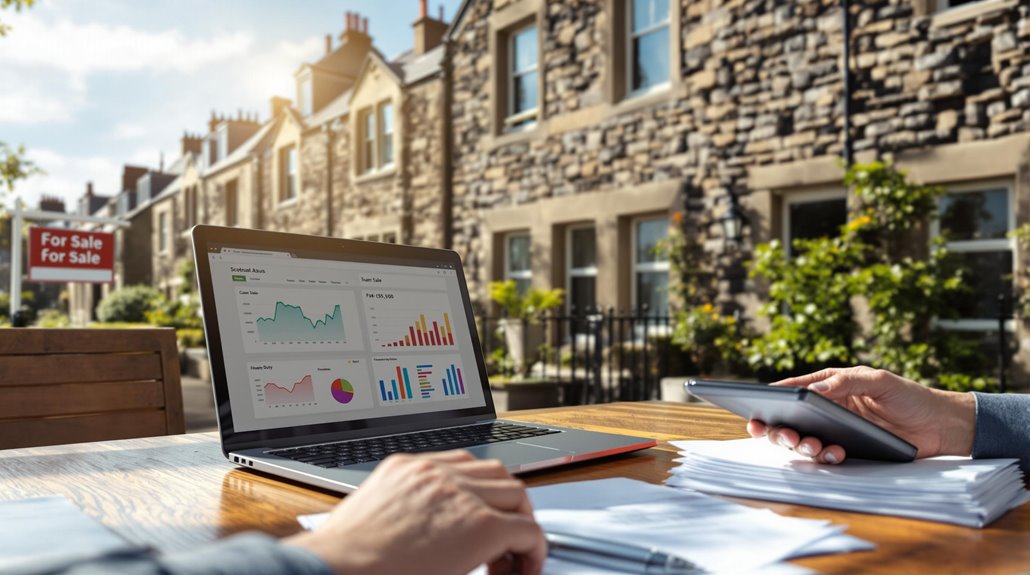
When purchasing property in Scotland, you’ll encounter Land and Buildings Transaction Tax (LBTT) rather than England’s Stamp Duty Land Tax. Understanding these rates helps you budget accurately for your Scottish property purchase.
LBTT operates on a tiered system with different rates applying to price bands. You’ll pay 0% on the first £145,000, 2% on amounts between £145,001-£250,000, and 5% on portions from £250,001-£325,000. Higher bands attract 10% and 12% rates respectively. This progressive structure means your marginal tax rate increases as the transaction value rises.
Here’s the vital difference: a £300,000 Scottish property incurs £4,600 LBTT, while the same property in England attracts only £2,500 SDLT. Scotland doesn’t offer first-time buyer relief either. Additionally, second homes face a 6% Additional Dwelling Supplement on the entire purchase price, making investment properties markedly costlier.
Long-Term Investment Performance Over the Decade
Scottish property has delivered substantial returns over the past decade, with house prices climbing nearly 43% between 2015 and June 2024. I’ll show you why this represents solid investment performance for savvy buyers like yourself.
You’ve witnessed remarkable resilience, with 2024 sales volumes exceeding the 2010-2024 average by 5.7%. While transactions remained 15.8% below 2021 peaks, the recovery’s strength is undeniable—98,674 sales marked a 5.4% annual increase. However, housing availability has become a growing concern, with 82% of Scots now rating this as a serious issue compared to the UK average of 72%. This issue is significant as affordable options are becoming increasingly scarce, impacting first-time buyers.
UK real estate projections indicate improved total returns ahead, driven by capital growth momentum. Income returns continue supporting long-term yields alongside resurgent appreciation. With mortgage costs now below average rental expenses, you’re positioned advantageously. Scotland’s regional stability spans most areas, creating opportunities for strategic property investors seeking consistent, decade-long performance.
Market Forecast and Prime Segment Analysis
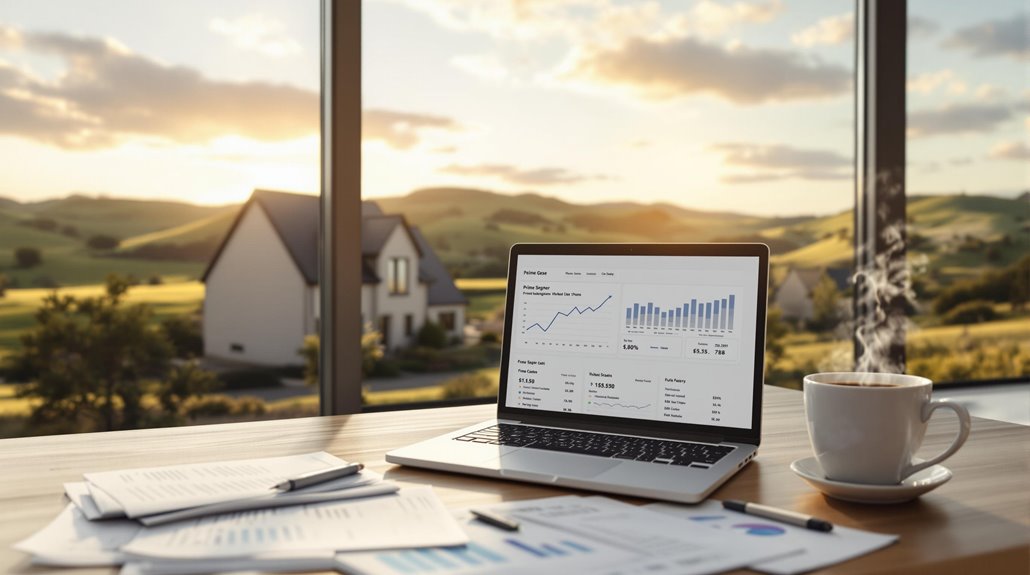
Looking ahead, Scotland’s property market shows promising signs with average house prices reaching £231,000 in Q4 2024—a 2.8% annual increase that sets the stage for continued momentum. I’m seeing experts forecast modest growth of 1–4% nationwide for 2025, with Glasgow positioned particularly well at 2–3% annual growth, potentially reaching 4%. The market’s underlying strength is supported by Scotland’s low unemployment rate of 3.9%, which sits below the UK average and continues to drive domestic housing demand. Additionally, a focus on buy-to-let investments is becoming increasingly popular among new investors, which could further enhance market stability.
What’s impressive is the prime segment’s resilience. Properties over £500,000 achieved 11% year-on-year sales growth in Q1 2025, outperforming the broader Scottish market’s 3% growth. You’ll find this premium tier remains stable despite tax hikes on additional homes, driven by equity-rich buyers targeting top school catchments.
Edinburgh leads regional performance with 6.8% price increases to £304,294, while West Lothian tops growth charts at 9.1%, giving you diverse investment opportunities across Scotland’s strengthening market.
Budgeting Strategy for Total House Purchase Costs
Beyond the headline purchase price, I’ll show you how to budget for the complete financial picture of buying a Scottish home. Start with your deposit—typically 10% (£18,600 for Scotland’s average £186,000 property). Add LBTT of £820 for that same property, plus conveyancing fees averaging £1,743. Don’t forget mortgage arrangement fees (£270 baseline), survey costs (£400-£1,000), and removal services (£1,044).
One effective way to uncover potential issues with a property before purchase is to conduct a thorough level 1 survey, which can lead to significant savings down the line. Here’s what separates successful buyers from stressed ones: allocate 1-3% contingency funds (£1,860-£5,580) for unexpected costs. Factor in immediate expenses like building insurance (£150 annually) and post-move essentials.
Your total upfront investment? Approximately £25,000-£30,000 for that £186,000 home. This thorough approach guarantees you’re financially prepared, not just pre-approved. Securing a mortgage in principle before house hunting demonstrates your borrowing capacity to sellers and helps focus your search within realistic price parameters.
Conclusion
I’ve shown you Scotland’s housing market offers genuine value at £191,000 average versus higher UK prices. You’ll need to budget beyond the purchase price—factor in your 5-20% deposit, £500-£1,500 legal fees, and LBTT calculations. I recommend calculating total costs upfront, not just the property price. With regional variations significant across Scotland, you’ll find opportunities if you research thoroughly and budget extensively for all associated expenses before committing.
References
- https://hoa.org.uk/advice/guides-for-homeowners/i-am-buying/the-hidden-costs-of-buying-and-owning-a-property/
- https://www.gov.uk/government/statistics/uk-house-price-index-for-april-2025/uk-house-price-index-scotland-april-2025
- https://www.savills.com/research_articles/255800/375896-0
- https://www.scotsman.com/lifestyle/homes-and-gardens/scottish-property-prices-2025-here-are-the-10-areas-of-scotland-with-the-biggest-rises-in-the-last-decade-5051254
- https://www.ros.gov.uk/about/news/2025/uk-house-price-index-figures-for-march-2025
- https://www.ros.gov.uk/about/news/2025/uk-house-price-index-figures-for-april-2025
- https://www.gov.uk/government/statistics/uk-house-price-index-for-february-2025/uk-house-price-index-scotland-february-2025
- https://www.gov.scot/publications/scottish-housing-market-review-q1-2025/pages/3/
- https://mov8realestate.com/2025/05/may-property-market-update-2025/
- https://espc.com/news/post/house-price-report

